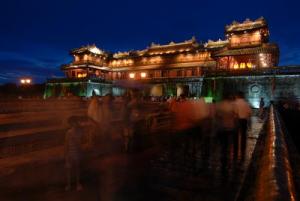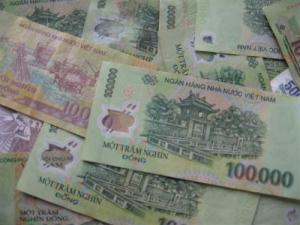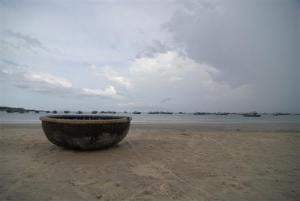Huong Pagoda Festival

Every year, when the spring comes, millions of people from all over Vietnam would travel to Ha Noi to take part in one of the country’s most elaborate festivals to welcome the Lunar New Year. Traditionally celebrated from the 6th day of the first month to the end of the third month in reference to the Vietnamese Lunar Calendar, this year’s Huong Pagoda Festival officially opened on February 19, 2010 in the midst of a very favourable weather. A Vietnamese custom, a pilgrimage to Huong Pagoda is said to bring health, prosperity, good luck and happiness. A mix of 600,000 pilgrims and tourists flocked the temple on the first day alone. Known as the longest and largest festival in Vietnam, the main festival days yet will begin on the 15th of the second lunar month and would last on the 20th day of the same month.
Consisting of a chain of temples and shrines, Chùa Hương, otherwise called as Perfume Pagoda, holds a long history of Vietnamese literature apart from being the most popular religious site in the country. This sanctuary is located in Ha Tay province, 70 km southwest of Ha Noi, which normally would require travellers about 2 hours of road trip to get to Ben Duc pier alone. Though the foot of the pagoda complex can be reached by road from the pier, using row boats to cross the Yen Vi river (ca 55000 Dong) is a more popular option for many because of the romantic view and breathtaking scenes that will unfold during the course of the 45-minute boat ride. This year, 4,600 boats will serve the monks, Buddhists and visitors at the Huong Pagoda Festival. The organizing board had given priority to foreigners because of the lack of upgraded boats more preferred by the tourists. And for the first time in the festival’s history, added boats will be launched to carry local artists who will be performing love duets (quan ho).
As a symbolic tradition, the boat ride makes a quick stop at Den Trinh (Registration Shrine) for visitors to "trinh" or register at the shrine and announce their intentions. And though there are several wonderful sites to visit at the Perfume Pagoda area; Hinh Bồng pagoda, Giải Oan pagoda, Thanh Sơn Pagoda, Long Vân, Cây Khế, Tuyết Sơn and Mẫu Mẹ temple to name a few, the trip highlights the Thiên Trù pagoda and the Hương Tích cave. The Thien Tru temple (heavenly kitchen), which is the boat’s next stop, is considered as the Outer Temple built back in the 18th century and is embedded with rock formations that resemble busy chefs working in the kitchen. The temple is also famous for a granite monolith, called Thuy Tien tower that stands on it. To its right, is another popular site, Tien Son grotto, which is famous for its five granite statues and the various formations on its cave walls. Such formations, when struck, produce percussion-like sounds like that of a popular Vietnamese musical instrument “khanh”, while the others produce bell-like sounds.
The visit continues to Dong Huong Tich (Huong Tich Cave or Inner Temple), in which pilgrims have to climb the hundreds of stoned steps, and during occasional stops, gives visitors a chance to contemplate on the beautiful landscape amidst the daily life of local farmers. As the temple lies deep within the grotto, visitors then need to take the 120 steps descending to Huong Tich Grotto, literally meaning "traces of fragrance", passing through a large gate at the cave’s entrance. The gate appears like a dragon’s mouth, in which above it, five Chinese characters are inscribed in the granite slab, reading Nam Thien De Nhat Dong (the most beautiful cave in the South), believed to be written by Vietnam ruler Trinh Sam (1767-1782). As not all visitors can endure the climb, cable car systems were built during the recent years. At 30000 Dongs for a one-way ticket, most visitors opt to go up by cable car and walk down to save energy yet still have the opportunity to enjoy the scenic views.
A showcase of Buddhist antiques and oil paintings were also featured on the festival’s opening ceremony. Thich Minh Hien, Huong Pagoda's chief monk, believes this to be the largest exhibition for Vietnamese Buddhism. The festival will run until April 28 and will include various cultural activities, folk games and traditional rituals. On top of that, a launching of 500 lotus-shaped lanterns in Yen Stream will be observed during the Buddhism Week to celebrate Ha Noi's 1,000th anniversary. The week-long celebration is said to begin on April 3.
The Huong Pagoda Festival is an amazing combination of romance, appreciation of nature and devotion to Buddha. The boat trip, sightseeing, mountain climbing, cave visit and religious ceremonies incorporated into one memorable celebration sets it apart from other festivals in the country. The Pagoda’s remarkable beauty and extraordinary landscape is a living proof of the Buddhist architecture harmonizing with nature, giving tourists an opportunity to relax and enjoy a moment of sooth and clam amidst all the noise and energy brought along by spring’s festivities. The Huong Pagoda Festival, in fact, is so well-recognized and has now been submitted for designation of UNESCO as a world cultural heritage site.









